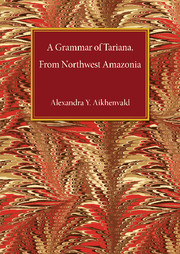Book contents
- Frontmatter
- Dedication
- Contents
- List of tables, schemes and diagrams
- Preface
- Acknowledgements
- Organisation and cross-referencing
- List of abbreviations
- Map
- 1 The language and its speakers
- 2 Phonology
- 3 Word classes
- 4 Nominal morphology and noun structure
- 5 Noun classes and classifiers
- 6 Possession
- 7 Case marking and grammatical relations
- 8 Number
- 9 Further nominal categories
- 10 Derivation and compounding
- 11 Closed word classes
- 12 Verb classes and predicate structure
- 13 Valency changing and argument rearranging mechanisms
- 14 Tense and evidentiality
- 15 Aspect, Aktionsart and degree
- 16 Mood and modality
- 17 Negation
- 18 Serial verb constructions and verb compounding
- 19 Complex predicates
- 20 Participles and nominalisations
- 21 Clause types and other syntactic issues
- 22 Subordinate clauses and clause linking
- 23 Relative clauses
- 24 Complement clauses
- 25 Discourse organisation
- 26 Issues in etymology and semantics
- Appendix. The main features of the Tariana dialects
- Texts
- Vocabulary
- References
- Index of authors, languages and subjects
12 - Verb classes and predicate structure
Published online by Cambridge University Press: 05 August 2013
- Frontmatter
- Dedication
- Contents
- List of tables, schemes and diagrams
- Preface
- Acknowledgements
- Organisation and cross-referencing
- List of abbreviations
- Map
- 1 The language and its speakers
- 2 Phonology
- 3 Word classes
- 4 Nominal morphology and noun structure
- 5 Noun classes and classifiers
- 6 Possession
- 7 Case marking and grammatical relations
- 8 Number
- 9 Further nominal categories
- 10 Derivation and compounding
- 11 Closed word classes
- 12 Verb classes and predicate structure
- 13 Valency changing and argument rearranging mechanisms
- 14 Tense and evidentiality
- 15 Aspect, Aktionsart and degree
- 16 Mood and modality
- 17 Negation
- 18 Serial verb constructions and verb compounding
- 19 Complex predicates
- 20 Participles and nominalisations
- 21 Clause types and other syntactic issues
- 22 Subordinate clauses and clause linking
- 23 Relative clauses
- 24 Complement clauses
- 25 Discourse organisation
- 26 Issues in etymology and semantics
- Appendix. The main features of the Tariana dialects
- Texts
- Vocabulary
- References
- Index of authors, languages and subjects
Summary
This chapter deals with verb classes and predicate structure. Verb classes are outlined in §12.1 (see §3.1.1 for a preliminary overview). In §12.2 I consider the structure of a predicate. §12.3 discusses the verb root structure and verbal derivations. Problems with defining a verbal ‘word’ in Tariana are addressed in §12.4.
Verb classes
Morphologically, Tariana verbs divide into those which take cross-referencing prefixes (prefixed) and those which do not (prefixless). Prefixless verbs have fewer morphological categories than prefixed ones (see §12.1.1). Most prefixed verbs are transitive, ambitransitive and active intransitive; while most prefixless verbs are stative intransitive. See §12.1.3.
Following Dixon (1991), we will first consider ‘primary’ verbs in Tariana, i.e. verbs ‘directly referring to some activity or state […] which can make up a sentence by themselves with appropriate NPs filling the various semantic roles’ (Dixon 1991: 88). Transitive verbs (covering ambitransitive, ditransitive and extended transitive verbs) are discussed in §12.1.1; intransitive verbs (which include active and stative intransitives, and also ‘oblique subject’ intransitive verbs) are considered in §12.1.2. Prefixless verbs with two arguments and extended intransitives are discussed in §12.1.3.
Difficulties in determining transitivity classes in Tariana arise from the problem of how to distinguish a non-A/S core argument from an oblique. We saw in Chapters 6 and 7 that A/S (where S covers Saand So) are cross-referenced on the (prefixed) verb. The same case-marking applies to any non-A/S constituent.
- Type
- Chapter
- Information
- A Grammar of Tariana, from Northwest Amazonia , pp. 234 - 257Publisher: Cambridge University PressPrint publication year: 2003



